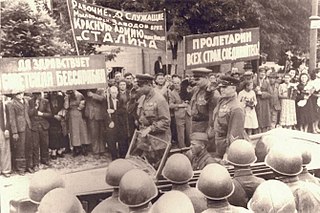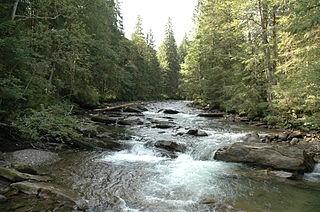
Tiraspol is the capital of Transnistria, a breakaway state in Moldova, where it is the second largest city. The city is located on the eastern bank of the Dniester River. Tiraspol is a regional hub of light industry, such as furniture and electrical goods production.

Bukovina is a historical region, variously described as part of either Central or Eastern Europe. The region is located on the northern slopes of the central Eastern Carpathians and the adjoining plains, today divided between Romania and Ukraine.

Chernivtsi Oblast is an oblast (province) in Western Ukraine, consisting of the northern parts of the regions of Bukovina and Bessarabia. It has an international border with Romania and Moldova. The oblast is the smallest in Ukraine by area and population.

The term Greater Romania usually refers to the borders of the Kingdom of Romania in the interwar period, achieved after the Great Union. It also refers to a pan-nationalist idea.

Hertsa Raion or Hertza Raion was an administrative raion (district) in the southern part of Chernivtsi Oblast in western Ukraine, on the Romanian border. The region had an area of 308.7 square kilometres (119.2 sq mi) and the administrative center in the city of Hertsa. It was one of the three raions of Ukraine with the majority of ethnic Romanian population. The raion was abolished on 18 July 2020 as part of the administrative reform of Ukraine, which reduced the number of raions of Chernivtsi Oblast to three. The area of Hertsa Raion was merged into Chernivtsi Raion. The last estimate of the raion population was 33,175
Moldova, officially the Republic of Moldova, is a country in southeastern Europe.

The Moldavian Autonomous Soviet Socialist Republic, shortened to Moldavian ASSR, was an autonomous republic of the Ukrainian SSR between 12 October 1924 and 2 August 1940, encompassing as well the modern territory of Transnistria. It was an artificial political creation inspired by the Bolshevik nationalities policy in the context of the loss of larger Bessarabia to Romania in April 1918. In such a manner, the Bolshevik leadership tried to radicalize pro-Soviet feelings in Bessarabia with a goal to return it in the presence of favorable conditions and creation of geopolitical "place d'armes" (bridgehead) to execute a breakthrough in the Balkan direction by projecting influence upon Romanian Bessarabia, which would eventually be occupied and annexed in 1940 after the signing of the Molotov-Ribbentrop Pact.

The historical regions of Romania are located in Central, Southeastern, and Eastern Europe. Romania came into being through the unification of two principalities, Wallachia and Moldavia in 1862. The new unitary state extended over further regions at various times during the late 19th and 20th centuries, including Dobruja in 1878, and Transylvania in 1918.

Hertsa or Hertza is a town located in Chernivtsi Raion, Chernivtsi Oblast in western Ukraine. It hosts the administration of Hertsa urban hromada, one of the hromadas of Ukraine, and has a population of 2,108.

The Hertsa region, also known as the Hertza region, is a region around the town of Hertsa within Chernivtsi Raion in the southern part of Chernivtsi Oblast in southwestern Ukraine, near the border with Romania. With an area of around 304 km2 (117 sq mi), it has a population of about 32,300 people, 93% of whom are ethnic Romanians.
This article represents an overview on the history of Romanians in Ukraine, including those Romanians of Northern Bukovina, Zakarpattia Oblast, and Budjak in Odessa Oblast, but also those Romanophones in the territory between the Dniester River and the Southern Bug River, who traditionally have not inhabited any Romanian state, but have been an integral part of the history of modern Ukraine, and are considered natives to the area. There is an ongoing controversy whether Moldovans are part of the larger Romanian ethnic group or a separate ethnicity.

The Soviet occupation of Bessarabia and Northern Bukovina took place from June 28 to July 4, 1940, as a result of the ultimatum by the Soviet Union to Romania on June 26, 1940, that threatened the use of force. Bessarabia had been part of the Kingdom of Romania since the time of the Russian Civil War and Bukovina since the dissolution of Austria-Hungary, and Hertsa was a district of the Romanian Old Kingdom. Those regions, with a total area of 50,762 km2 (19,599 sq mi) and a population of 3,776,309 inhabitants, were incorporated into the Soviet Union. On October 26, 1940, six Romanian islands on the Chilia branch of the Danube, with an area of 23.75 km2 (9.17 sq mi), were also occupied by the Soviet Army.

The ethnic Romanians of Chernivtsi Oblast in Ukraine comprise a significant portion of the Romanian diaspora in Ukraine.

Dorohoi County, with its seat at Dorohoi, was a subdivision of the Kingdom of Romania and located in the region of Moldavia.
The Hertsa or Hertza is a right tributary of the river Prut in Romania and Ukraine. It flows through the town Hertsa, and discharges into the Prut near Marshyntsi. In Romania, its length is 6 km (3.7 mi) and its basin size is 23 km2 (8.9 sq mi).
Herta may refer to the following:

The Prut is a 953 km (592 mi) long river in Eastern Europe. It is a left tributary of the Danube. In part of its course it forms Romania's border with Moldova and Ukraine.

Moldavia, also called Western Moldavia or Romanian Moldavia, is the historic and geographical part of the former Principality of Moldavia situated in eastern and north-eastern Romania. Until its union with Wallachia in 1859, the Principality of Moldavia also included, at various times in its history, the regions of Bessarabia, all of Bukovina, and Hertsa; the larger part of the former is nowadays the independent state of Moldova, while the rest of it, the northern part of Bukovina, and Hertsa form territories of Ukraine.

Greater Moldova or Greater Moldavia in an irredentist concept according to which the territories of the Republic of Moldova should be expanded to the lands that used to belong to the Principality of Moldavia, specifically including Western Moldavia and the whole of Bessarabia, as well as Bukovina and the Hertsa region and, sometimes, parts of Transylvania. The idea of Greater Moldova was briefly promoted by the Soviet Moldavian politician Nikita Salogor in the aftermath of World War II, and has seen some marginal resurgence in the 21st century.













